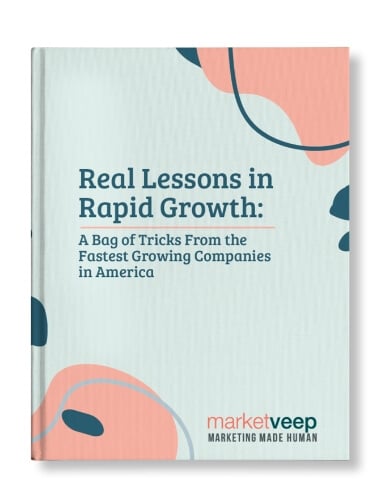How Does Inbound Marketing Work?


By Market Veep
The four stages of the inbound marketing methodology are: Attract, Convert, Close, and Delight. Inbound marketers use helpful content and easy methods of "opting in" to attract business organically and keep customers coming back for more. It's drastically different than traditional methods of outbound marketing, which include cold calling and untargeted advertising.
Table of Contents:
Inbound marketing is the practice of attracting customers through content and interactions that are relevant and helpful — not interruptive. Instead of interrupting someone’s dinner with a phone call, you post content online, such as blogs, eBooks, seminars, and videos.



You let people find you when they’re doing research. The practice is subtle and provides customers with help when they need it, rather than a sales pitch while they're trying to catch up on Game of Thrones.
The average person is exposed to hundreds of advertisements each day: cold calls, mailers, flyers, billboards, TV commercials, you name it. People are so accustomed to ads that they often tune them out completely. They’ve become nothing more than a frustration, and they may even be a waste of money for your businesses.
Most traditional forms of marketing are no longer effective, especially for marketers on a budget. The best way to get noticed now isn’t by forcing your message. It’s by giving them a good reason to reach out to you on their own.
Inbound marketing would not be possible without the internet. And because of the web’s vast popularity, it’s now the perfect place to find your customers. People typically get online to look for information that can help them solve a problem, answer a question, or expand their knowledge.
Both consumers and B2B purchasers engage with online content, so you can use inbound marketing regardless of whom you serve.
Traditional advertising is now referred to as outbound marketing. It places the importance of the product, service, or company above the importance of the customer. You may be surprised to learn that outbound marketing is actually more expensive than inbound. A recent Hubspot study found that leads obtained through inbound marketing cost 62% less than those obtained through outbound marketing.
The Inbound Marketing Methodology
If you’re not entirely convinced or you want more specifics, the best way to fully understand inbound marketing is through the inbound marketing methodology. This is the typical process a business goes through to obtain a customer. Consequently, it’s also the typical process a buyer goes through to become a customer:

There are four stages in the inbound methodology: Attract, Convert, Close, and Delight. A stranger will enter at the “Attract” stage, usually by finding a piece of content online.
At this stage, they are a visitor. Once they fill out a form for more free content, they become a lead. Using other tactics, like email marketing and social media marketing, a business then moves that lead closer toward a buying decision. Once they are ready to purchase, all friction between them and their decisions should be gone.
You’ll notice that the inbound methodology doesn’t end when a lead becomes a customer. Just because someone has given you their money doesn’t mean their customer lifecycle is over. You want to provide them with an excellent product or service, sure, but you can go even further by offering special offers and positive interactions.
By delighting them, you’ll have a better chance of them sharing your content and talking up your brand to their friends.
Attract
Let’s say you write a blog post detailing how to start a youth football league and it goes viral. Congratulations! But it probably won’t do your business much good if you’re a financial consultancy that serves big companies in Europe.
Getting lots of traffic on your website is a worthy goal, but you also want to attract the right types of people. You can do this by creating content that addresses the typical needs of your ideal customers. That content can take many forms, but it has to be helpful -- not a sales pitch.
Here are some examples of top-level content:
-
Blogging
Each blog post is an opportunity to rank for a search query, or keyword. Create educational content that speaks to your customers, answers their questions, and solves their problems. Your blog will be your primary driver of organic web traffic. Furthermore, by embedding CTAs (Calls to Action) in your posts, you’ll give your visitors an opportunity to convert into leads.
-
SEO
Customers begin their research and buying process online, usually through the use of a search engine. You want your web pages to appear prominently and frequently in their search results. To do so, you need to pick keywords, optimize your pages for those keywords, create content, and build links around the terms your buyers search for.
-
Pages
The pages of your website should provide visitors with detailed information about your business. Each page must accomplish a specific goal. For example, most businesses have pages dedicated to the products and services they provide, an about page detailing what their company does, and a homepage with a positioning statement and more basic information.
-
Social Publishing
Social publishing allows you to share your valuable content on social media, which enables you to engage with your prospects in a manner that’s approachable. Customers may find you organically on social media, but you can also use it to delight existing customers and post digital ads.
Convert
This is the stage in which site visitors become leads. This process is the result of successful content marketing that has enticed perspectives enough to want to get in contact with your business. To become a lead, a site visitor must give you their contact information, thereby opting in for marketing communications. Here’s how you can capture their contact information:
-
Forms
Site visitors can fill out a form and submit their information. It’s important to optimize your form to make this step as easy as possible. Place forms on all of your web pages to ensure no visitors miss an opportunity to fill one out. Include call-to-action language on your forms and a clear message as to what they are signing up for.
-
Calls-to-Action
These are buttons or links that encourage your visitors to “take action.” for example, you could place a button that says “Download Our Free eBook” at the bottom of one of your blog posts. You can also place generic “contact us” CTAs at the top of your web pages, or CTAs about special offers.
-
Landing Pages
When a website visitor clicks a call-to-action, they are sent to a landing page. A landing page is where the offer in the call-to-action is fulfilled, and where the prospect submits information. This is how site visitors become contacts. If you run digital ads, you will most likely direct people who click on them to a landing page.
-
Contacts
Keeping all of your data in one place helps you make sense of every interaction you have with your contacts - be it email opens, website visits, or blog post reads.
Close
In this stage, a lead becomes a customer. This is when all your previous efforts pay off. Typically, most of your website visitors, and maybe even most of your leads, will not become customers. But creating a good system at each stage of the methodology will ensure you don’t miss any genuine opportunities.
Closing will inevitably involve a sales process. The inbound sales methodology is similar to the marketing side. The stages are Identify, Connect, Explore, and Advise.
If you use an inbound marketing agency or plan on having your in-house marketing team follow the inbound methodology, you may want to ensure your sales team follows the inbound sales methodology.
Here’s how to close customers using inbound marketing:
-
CRM
Keep track of the details regarding all the contacts, companies, and deals in your pipeline. Customer Relationship Management (CRM) systems enable you to have the right information at your fingertips. If you can, let your sales team and marketing team share the same CRM so there is no confusion about when to hand over leads.
-
Closed-loop Reporting
Integration with your CRM system allows you to analyze your marketing and sales teams performance. This type of reporting can give you a good idea of how smoothly your leads are moving from marketing to sales. It can also help you identify specific issues that need to be fixed.
-
Email
A series of emails focused on useful/relevant content can build trust with a prospect and help them become more ready to buy. With the right CRM, you can keep track of every email interaction you have with a lead.
-
Marketing Automation
This process involves creating email marketing and lead nurturing tailored to the needs and lifecycle stage of each lead. Your marketing team can use automation to send lifecycle sensitive marketing materials to your leads. Your sales team can use automation to ensure they never miss a connection.
Delight
This is the stage of the inbound methodology that often gets neglected. Just because you’ve closed a sale doesn’t mean the customer’s journey is over. You always want to delight anyone that interacts with your company so that they may become promoters.
To delight your customers, you should provide them with top-notch products and services, but you can also offer great content and an opportunity to provide feedback. For example:
-
Surveys
Use feedback questionnaires and surveys to ensure you’re providing customers with what they’re looking for. Surveys also provide you with useful data that could shed light on your marketing and sales process or even the quality of your product or service.
-
Smart Calls-to-Action
These present different users with offers that change based on buyer persona and lifecycle stage. If one of your customers visits your website, you don’t want to offer them the same content a new visitor might see. They may be looking for customer service, technical support, or some other type of assistance.
-
Smart Text
Provide customers with written content that’s tailored to their interests and challenges. Help them achieve their goals and introduce them to new products and features. Like smart calls-to-action, smart text changes based on who is reading, so your new visitors will see your default content.
-
Social Monitoring
Listen for customer questions, comments, likes, and dislikes – and reach out to them with relevant content. If you’re particularly savvy on social media, you can even have fun exchanges with your customers to humanize your brand.
That's Inbound Marketing
As you can see, inbound marketing is now the best way to interact with today’s customers. It's the direction marketing has been moving towards for the past decade, and it will only continue to grow. No one likes having content or advertisements forced on them. And nowadays, people meet that practice with serious scrutiny.
You want your content to blend in and passively appeal to those qualified prospective customers your company wants. This strategy is the most digestible for both consumers and B2B purchasers. If practiced correctly, it can help you create lasting relationships with your customers.
Get The Latest From
Market Veep
RELATED ARTICLES

Master Sales Funnel Strategies: Tofu Mofu Bofu!
Between SEO, SEM, and SERPS, we’re always finding clever ways to break down concepts into four...

A Complete Guide for HubSpot CRM Implementation
HubSpot, a CRM platform that’s trusted by over 205,000 customers in countries all over the world,...

Intro to HubSpot Email Sequences & Best Practices
But what exactly are HubSpot sales sequences, and how do they work?

Get Growing!
Download our eBook and get advice from 8 CEOs of Inc. 5000 companies in their own words.

GREAT MARKETING PARTNER
Market Veep is a great firm that handles all of our marketing efforts. This is the second time that I have used the firm. I highly recommend Market Veep!

Cres F.

EXCEPTIONAL EXPERIENCE
Market Veep's Onboarding Experts in Inbound Marketing are an absolute game-changer! From the get-go, their approach was top-notch. Market Veep's team has undoubtedly set the bar high for excellence in inbound marketing. Five stars aren't enough to commend their outstanding service!

Matthew W.

BEST PARTNER EVER!
As a growing business, setting up our first-ever HubSpot account was a crucial step towards enhancing our marketing and customer management strategies. From the moment we contacted MarketVeep, their team demonstrated professionalism, expertise, and a genuine desire to help us succeed. Overall, our experience with MarketVeep was exceptional, and we couldn't be happier with the results. Thanks to their guidance, we are now utilizing HubSpot to its fullest potential, streamlining our marketing efforts, and nurturing leads more effectively.

Jean M.

SET UP FOR SUCCESS!
We had an exceptional experience with Market Veep! Their team is professional, super organized, and friendly, and I truly enjoyed working with them. They executed on time and made the process super easy with their organization and documentation. In addition, they provided additional guidance and answered my many questions as I was new to HubSpot, and provided documentation resources for future use. We're now set up to leverage all that HubSpot marketing has to offer, and we couldn't have done it without Market Veep's expertise.

Bailey G.

OUTSTANDING WORK
There aren't enough words to describe the outstanding, professional work MarketVeep has provided to our company. From start to finish, the website design/development team at MarketVeep assigned to our project was extremely knowledgable, respectful, efficient and timely. The results went above and beyond our expectations and we could not be more thrilled with the improvements to the user experience on our website! Bravo MarketVeep, we'll absolutely be back with more projects!

Nadine B.

5 STARS FOR MARKET VEEP!
We had a fantastic experience with Market Veep! Their expert team seamlessly guided us through implementing HubSpot and provided comprehensive training across Sales, Service, and Marketing Hubs. Their knowledge and support significantly enhanced our workflow and overall efficiency. Highly recommend Market Veep for top-notch HubSpot solutions!

Anneke C.







